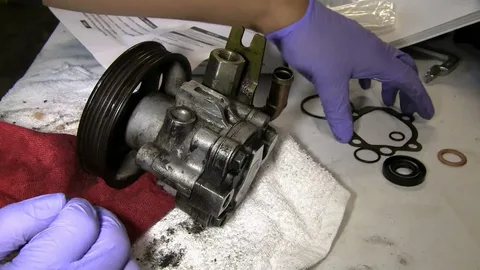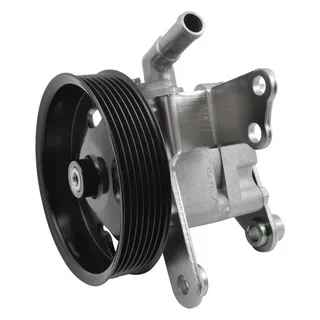Is your steering wheel feeling stiff and difficult to turn? It could be time to check your VE power steering pump. This crucial component of your car’s steering system helps make turning the wheel effortless, but it can wear out over time and cause problems. In this blog post, we’ll discuss some tips for maintaining your power steering pump and keeping your steering smooth and responsive. Say goodbye to stiff steering and hello to a more enjoyable driving experience with these helpful tips.
Understanding the Power Steering Pump
The power steering pump is vital to your car’s steering system. It’s responsible for generating the necessary hydraulic pressure to turn the wheels. Without it, you would have to exert much more effort to steer your vehicle, especially at lower speeds. Inside the power steering pump, a hydraulic system is at work. When you turn the steering wheel, a belt connected to the engine powers the pump. This creates pressure in the system, which is then used to assist with turning the wheels.
The pump comprises various components, including a rotor, vanes, and housing, all working together to provide smooth steering. Understanding how the power steering pump operates can help you identify and address potential issues before they become major problems. It’s important to note that different cars may have slightly different designs for their power steering pumps, so it’s always best to consult your vehicle’s manual for specific details.
Signs that Your Power Steering Pump Needs Attention
Is your steering wheel feeling heavier and more difficult to turn than usual? This could be a sign that your power steering pump needs attention. A failing power steering pump can lead to many problems, including stiff steering, erratic steering response, and even a complete loss of power steering. It’s important to be aware of the signs that indicate your power steering pump is in trouble so you can address the issue before it worsens.
- One common sign of a failing power steering pump is a groaning or whining noise when you turn the steering wheel. This noise is typically caused by air in the system or a worn-out pump.
- Another indicator is a vibration or jerking sensation in the steering wheel while turning, which can be a sign of a pump struggling to provide enough pressure.
- Leaking power steering fluid also indicates that your power steering pump needs attention. Check under your car for any puddles of fluid, or inspect the power steering fluid reservoir for any noticeable drops in fluid level. Low power steering fluid can cause a loss of hydraulic pressure, leading to difficulty turning the wheel.
- Pay attention to any changes in your steering performance. If you find it increasingly difficult to steer your vehicle, especially at lower speeds or while parking, it’s likely that your power steering pump needs to be fixed.
How to Troubleshoot Power Steering Pump Issues?
When it comes to troubleshooting power steering pump issues, there are a few key steps you can take to identify and address the problem:
- Start by checking the power steering fluid level. If it’s low, it could indicate a leak in the system or a problem with the pump itself.
- Inspect the power steering belt for any signs of wear or damage. A worn-out belt can affect the pump’s performance and lead to steering difficulties.
- Listen for unusual noises when turning the steering wheel, which could indicate a failing power steering pump.
- If you’re still experiencing issues, it’s best to consult a professional mechanic who can diagnose the problem and recommend the appropriate course of action.
By following these troubleshooting steps, you’ll be well on your way to resolving power steering pump issues and enjoying smoother steering.
Replacing Your VE Power Steering Pump – A Step-By-Step Guide
Replacing your VE power steering pump may seem daunting, but with this step-by-step guide, you’ll be able to tackle it confidently. Here’s what you need to do:
Gather the necessary tools:
Before you begin, ensure you have all the necessary tools for the job. This may include a wrench, socket set, power steering pulley puller, and a power steering pump replacement kit.
Prepare your vehicle:
Start by turning off the engine and disconnecting the battery’s negative terminal to prevent any accidental electrical discharge. Then, raise the front of your vehicle and secure it with jack stands to create a safe working environment.
Remove the old power steering pump:
Locate the power steering pump, typically found at the front of the engine. Remove the serpentine belt from the pulley by releasing the tensioner. Disconnect the hoses connected to the pump, making sure to catch any spilled fluid with a drain pan.
Install the new power steering pump:
Take your new power steering pump and attach the pulley using a power steering pulley puller. Connect the hoses to the new pump, ensuring they are secure and leak-free.
 Reassemble and test:
Reassemble and test:
Reinstall the serpentine belt, ensuring it is properly aligned on all pulleys. Reconnect the negative terminal of the battery. Start the engine and check for any leaks or unusual noises. Turn the steering wheel to verify that it is smooth and responsive.
Maintenance Tips for Your Power Steering Pump
Proper maintenance is key to keeping your power steering pump in optimal condition and ensuring a smooth and responsive driving experience. Here are some maintenance tips to help you take care of your power steering pump:
Regularly check the power steering fluid:
The power steering fluid is crucial for the smooth operation of your pump. Check the fluid level regularly and top it off if necessary. Also, inspect the fluid for any signs of contamination or discoloration, as this can indicate a problem with the pump or the system.
Follow the manufacturer’s recommended service schedule:
Different cars may have different maintenance intervals for the power steering pump. Please consult your vehicle’s manual and follow the recommended service schedule diligently. This may include flushing and replacing the power steering fluid at certain intervals.
Inspect for leaks:
Leaking power steering fluid is a clear sign of a problem with the pump or another system component. Regularly inspect under your car for any puddles of fluid or check the power steering fluid reservoir for any drops in fluid level. If you notice a leak, have it inspected and repaired as soon as possible.
Choosing the Right Power Steering Pump for Your Car
When choosing the right power steering pump for your car, there are a few important factors to consider.
- You must ensure that the pump is compatible with your specific make and model. Different vehicles may have different power steering pump requirements, so it’s crucial to consult your car’s manual or speak to a professional mechanic for guidance.
- Another important factor to consider is the quality of the pump. Investing in a high-quality power steering pump may cost you more upfront, but it can save you money in the long run. A reliable and durable pump will last longer and perform better, providing a smoother and more responsive steering experience.
- It’s also important to consider the warranty offered with the power steering pump. A reputable manufacturer will stand behind their product and offer a warranty that covers any potential defects or malfunctions. Be sure to carefully read the warranty terms and conditions to understand what is covered and for how long.
- Consider the reputation of the brand. Look for a trusted and well-known manufacturer with a good track record in producing reliable, high-quality power steering pumps. Reading customer reviews and seeking recommendations from other car owners can also help you make an informed decision.
Common Power Steering Pump Problems
One of the most common power steering pump problems is a leak. Leaking power steering fluid can occur due to worn-out seals or hoses, leading to a loss of hydraulic pressure and difficulty turning the wheel. If you notice puddles of fluid under your car or a decrease in the power steering fluid level, it’s important to have the leak inspected and repaired as soon as possible. Another problem with power steering pumps is the air in the system. Air can enter the system through a leak or during repairs, causing the steering to feel stiff or jerky.
Bleeding the power steering system can help remove the air and restore smooth steering. Worn-out or damaged components within the power steering pump can also lead to issues. The rotor, vanes, or housing may become worn over time, affecting the pump’s performance and causing symptoms such as whining or groaning when turning the wheel. A failing power steering pump may struggle to provide enough pressure, resulting in a loss of power steering or a stiff and unresponsive steering wheel. If you experience any common power steering pump problems, addressing them promptly is crucial.
FAQs
Q: How often should I check my power steering fluid?
A: It’s a good idea to check your power steering fluid level at least once a month. This will help ensure that you have enough fluid to keep your power steering pump working properly.
Q: Can I use any power steering fluid in my car?
A: No, it’s important to use the power steering fluid your vehicle manufacturer recommends. Using the wrong type of fluid can damage your power steering system.
Q: How do I know if the VE power steering pump needs to be replaced?
A: There are a few signs that may indicate a need for a new power steering pump, such as difficulty turning the wheel, strange noises when turning, or leaks. If you’re experiencing any of these issues, having your pump inspected by a professional is best.
Q: Can I replace my power steering pump myself?
A: While replacing your power steering pump yourself is possible, it can be a complex task requiring specific tools and knowledge. If you need more confidence in your abilities, it’s best to leave it to a professional mechanic.
Conclusions
Maintaining your power steering pump is essential for ensuring smooth and responsive steering in your vehicle. By understanding how the pump works and being aware of the signs of trouble, you can address issues early on and prevent further damage. Regular maintenance, such as checking the fluid levels and inspecting for leaks, can help keep your power steering pump in optimal condition. Following a step-by-step guide or seeking professional help can make the process easier when replacing the pump. Remember, a well-maintained power steering pump can greatly improve your driving experience.



